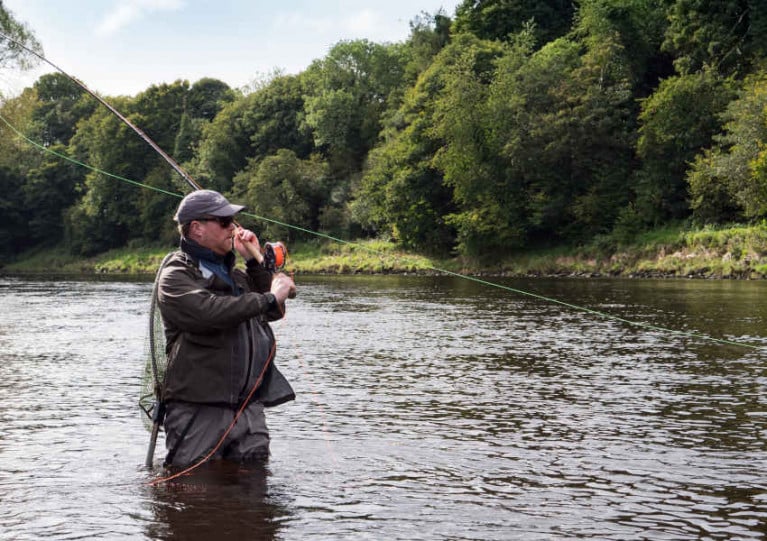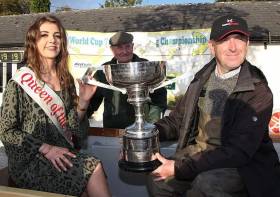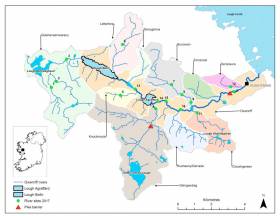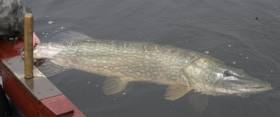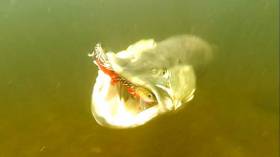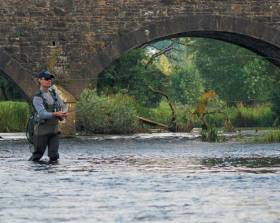Displaying items by tag: trout
Goatsbridge Trout Farm to Scale up Production After Completing €1.68m Investment, With Support from BIM
Goatsbridge Trout Farm in Thomastown, Co. Kilkenny, has completed a €1.68 million investment, which will allow it to increase production of its popular trout products and improve efficiencies. The investment, which included a factory extension, upgrading and introducing new state-of-the-art production lines, and installing solar panels, was supported with grant aid of €666,540 from the Brexit Processing Capital Support Scheme and the Brexit Sustainable Aquaculture Growth Scheme, administered by Bord Iascaigh Mhara (BIM).
The new investment will also protect the current 27 jobs in the business and hopefully increase the numbers employed in the next year. Goatsbridge produces smoked trout, trout pâté, fish chowder, and Ireland's only caviar made from trout roe. The investment will transform the business, which is run by Mag Kirwan and her husband Ger, allowing it to pursue its strategy to produce more high-volume, high-margin products to increase domestic and overseas sales.
The investment will also pave the way for the business to become carbon-neutral in the coming 3 to 5 years. "We want to be sustainable not just from a business point of view, but more importantly, from an environmental point of view. We want to protect what we have for generations to come," said Mag Kirwan.
The Brexit Processing Capital Support Scheme and the Brexit Sustainable Aquaculture Growth Scheme will deliver up to €65 million in funding to the Irish seafood processing sector. Both schemes are funded by the European Union under the Brexit Adjustment Reserve and are recommendations of the Seafood Taskforce established by Minister for Agriculture, Food, and the Marine, Charlie McConalogue T.D.
According to Mags Kirwan, the investment will improve energy efficiency. "As well as solar panels, we have upgraded existing doors to improve temperature control in the production area, and added a blast chiller to improve the processing of products including caviar." The new solar panels will radically cut down on Goatsbridge's energy costs, reducing the impact of climate change on the business.
 Ger and Mag Kirwan pictured at the new solar panels at Goatsbridge Trout Farm in Thomastown, Co. Kilkenny. The panels which will improve energy efficiency at the farm were supported with grant aid under the Brexit Adjustment Reserve scheme
Ger and Mag Kirwan pictured at the new solar panels at Goatsbridge Trout Farm in Thomastown, Co. Kilkenny. The panels which will improve energy efficiency at the farm were supported with grant aid under the Brexit Adjustment Reserve scheme
Goatsbridge products are available in Irish retail outlets and are sold in 400 Sainsbury's outlets in the UK. Recently, the company landed a deal to stock its popular products through the Ocado online food company in the UK. Goatsbridge is currently pursuing exports further afield, with negotiations underway for a possible listing in the Dubai-based Spinneys supermarket and grocery chain, which has more than 65 locations across the UAE.
BIM CEO Caroline Bocquel said, "It is great to see at first hand the positive impact of the Brexit Processing Capital Support Scheme on fish businesses, including Goatsbridge. Mag and Ger have been true champions in the Irish seafood industry for almost 30 years and are constantly adapting and innovating and seeking to be more efficient."
Goatsbridge Trout Farm was started by Ger Kirwan's father, Padraig, in 1961 when he created the first fish ponds on The Little Arrigle River in the heart of the Nore Valley. Ger and Mag took over the business in 2002.
Public Consultation on Trout Bag Limit and Size Limit for Lough Lene
Inland Fisheries Ireland (IFI) is seeking submissions from interested parties in respect of a proposed new angling bye-law which would set a minimum length and bag limit for trout caught and retained from Lough Lene.
At present there is no minimum length size for any trout caught and retained by rod and line on Lough Lene in Collinstown, Co Westmeath — nor is there any bag limit for trout.
The draft bye-law aims to assist with the sustainable management of the fishery by limiting the numbers of trout, of all sizes, being taken from the lake.
It aims to set a minimum length of 36cm (14 inches) a bag limit of not more than two per day for trout caught and retained on the waters of Lough Lene.
All submissions must be received in writing. Please be aware that all submissions received by IFI will be published on its website.
In addition, IFI is subject to the provisions of the Freedom of Information Act 1997 and therefore has to consider any request made to it under that act.
If you consider that any part of your submission would be subject to any of the statutory exclusions under that act, this should be indicated in your submission, specifying under which exemption you believe the content should be excluded.
IFI will make every effort to comply fully with the Data Protection (Amendment) Act 2003 and the EU Data Protection Directive 95/46/EC
Submissions should be clearly marked ‘ERBD Byelaw Consultation’ and sent by post to the Director, Inland Fisheries Ireland Dublin, 3044 Lake Drive, Citywest, Dublin 24 or alternatively by email to [email protected].
The public consultation period opened earlier this week and the closing date for receipt of submissions is 5pm on Tuesday 22 February.
While some anglers enjoyed success on the rivers within Foyle and Carlingford in 2020, the Loughs Agency says it continues to take a precautionary approach in line with national and international trends.
The State of the Salmon Report published by the international lead on salmon management, the North Atlantic Salmon Conservation Organization (NASCO), highlights the worrying and continuous decline in the populations of the Atlantic salmon.
NASCO states: “It now takes about double the amount of eggs to produce one adult (compared to 1990s) that will return to that same river to spawn — an indication of the multiple pressures facing the species throughout its complex life cycle.”
This decline continues to be reflected locally, the Loughs Agency warns, with rivers such as the Finn in Co Donegal failing to reach their conservation targets in 2020 and therefore will continue to operate on a catch and release basis for the 2021 season.
Now the agency is calling on anglers to take steps to ensure sustainability of the fisheries of Foyle and Carlingford. Anglers are encouraged to:
- Update their catch return and fishing effort regularly throughout the season on the eLicence website. This data is used to help Loughs Agency manage the fishery using real-time data.
- Keep the Loughs Agency’s 24hr Response Line telephone number +(0) 44 2871 342100 as a contact on their phone and report any concerns directly and promptly. The Loughs Agency relies on reports of illegal fishing and pollution from the public.
- Practice catch and release. Many anglers already do this, with around 45% of anglers not taking carcass tags when they purchase their licence.
- Implement biosecurity measures to prevent the spread of invasive species.
- For the 2021 season, the Loughs Agency is issuing a maximum of one blue tag for the period 1 March to 31 May and/or a maximum two black tags for the period 1 June to 31 October, depending on the type of licence purchased. Tackle shops have been instructed not to issue more than these maximum quantities for the 2021 season.
The rivers Film and Foyle opened this past Monday 1 March, signalling the start of the salmon, sea trout and wild brown trout angling season. However, game, coarse and sea angling is already available in both catchments.
For still water game anglers, Binevenagh Lake opened on 1 February. The lake lies on a basalt plateau that towers over Lough Foyle and its flanking lowlands below with the famed hills of Donegal beyond.
The 3.2 hectare lake is regularly stocked with rainbow trout by DAERA Inland Fisheries and successful flies include Bibio and Buzzer patterns.
Fly fishing, spinning and worm fishing are permitted and the fishery has a daily bag limit of four trout per rod. A Loughs Agency game rod licence and a DAERA game angling permit are required to fish this water.
Some private fisheries are also operating and offer fishing for rainbow trout including Ballyheather, Altmore, Birchwood, Cashel, Termon, Oaks, Glenowen, and Duncrun Fishery in the Foyle area. In the Carlingford area, Donaghaguy Reservoir is open for trout fishing. A Loughs Agency game licence and a permit from the relevant fishery are required to fish these waters.
 Coarse angling on the Newry Canal | Photo: Loughs Agency
Coarse angling on the Newry Canal | Photo: Loughs Agency
Coarse angling is permitted all year round, but the climate impacts on which species can be targeted. While tench, bream and rudd are active in warmer weather, roach and perch feed in all seasons and make good year round fishing for the coarse angler.
In the Foyle area, coarse fishing is currently available at Aghlisk Lough, Baronscourt Lakes, Enagh Lough, Longvale and Lough Muck near Omagh. In Carlingford, anglers can also fish for roach and perch at Bessbrook, Camlough, Derryleckagh, Drumlough, Greenan Lough, Mill Dam, Milltown Lough and in Newry Canal. A Loughs Agency coarse licence and permission from the relevant fishery owner is required to fish these lakes. In some cases a day ticket must be purchased.
The marine waters in Foyle and Carlingford offer fantastic sea angling with stunning landscapes and seascape backdrops. Flounder, bass, dogfish, dab, rockling, conger, pollock and ray are likely catches for the shore angler.
The Foyle area has over 90 miles of coastline of inlets, beaches, estuaries and rocky shores from which to cast from, while Carlingford offers almost 30 miles of coastline opportunities to fish. No licence is required for sea angling, but if fishing for salmon or sea trout a Loughs Agency game licence is required for the season.
Anglers are reminded to comply with the latest government advice and restrictions to stop the spread of COVID-19. For further information on season dates, licence and permit requirements in the Foyle and Carlingford areas, visit the Loughs Agency website’s angling section HERE.
Fly World Cup Goes To Leitrim Angler After Month-Long Championship
Leitrim angler Bernard Kilkenny claimed the World Cup in trout fly angling on Lough Mask last weekend, as Derek Evans notes in today’s Irish Times.
His five trout at 5.73lb secured the title — as well as a boat with 15HP outboard, and a new rod and reel — in what was “the most drawn-out in the 63 years of the championships”, with poor weather meaning three attempts over a whole month were required.
Elsewhere, two anglers caused a headache for marine wildlife lovers in Wicklow yesterday (Sunday 8 September) when they were spotted fishing just meters from a protected seal colony.
According to Wicklow News, the men had ignored signs warning away from the seals, as well as the pleas of several onlookers, but left the area after they were spoken to by gardaí.
It is recommended that the public stay at least 100 metres away from seals as they enter their breeding season and seek safe space on land from September to the end of the year.
Plan Published For Recovery Of Salmon & Trout Stocks In Owenriff Catchment
#Angling - Inland Fisheries Ireland has published its 2017 fish stock survey for the Owenriff catchment as well as its rehabilitation plan for the system to promote the recovery of brown trout and salmon in its lakes and rivers.
The Fish Stock Survey — which was conducted in the summer of 2017 and forms the basis for the Rehabilitation Plan — deduces that the introduction of pike into the catchment has been the significant factor in the declining fish stocks.
“As there are little or no major anthropogenic pressures in the catchment to cause the decline in fish stocks, it is reasonable to infer that the introduction of pike and their subsequent range expansion in the Owenriff catchment (with impacts of competition for food and space and predation on resident and migratory fish) is the main factor causing the decline of brown trout and salmon in the Owenriff catchment. Research from Europe and North America supports this finding,” the reports states.
Anthropogenic pressures include human-induced factors such as urban growth, deleterious discharges, farming activities and introduction of alien species.
Although pike were captured for the first time by IFI staff in 2009 in two lakes in the catchment (Loughs Bofin and Agraffard) and efforts were made by IFI staff to remove the pike from the system, they did not show up in two catchment-wide surveys in 1997 and 2007 and were only officially recorded in a survey for the first time in 2015.
However, the latest report, from the 2017 survey, confirms that pike are present all over the Owenriff catchment “in areas where they can freely gain access and in some areas where they cannot naturally gain access.”
Welcoming the publication of the two reports, Minister Sean Kyne TD said: “We have acted swiftly since the interim results of this survey became known. In late January, I announced that Inland Fisheries Ireland is to commence fish stock management operations on the Owenriff catchment to protect and restore trout stocks which have been impacted by recent introductions of pike to the catchment.
“The consequences of not taking wider remedial action on the basis of these survey results would lead to further decline in ecological biodiversity in the catchment, so I very much welcome the publication by IFI of the Owenriff Fish Population Rehabilitation Plan 2018.”
The minister continued: “The purpose of the plan is to develop a fisheries rehabilitation project that can be undertaken on the catchment to promote the recovery of the brown trout (both resident and migratory Corrib) and salmon populations in both lakes and rivers. It will take time and will be costly, but we are already underway with this very constructive and positive roadmap.”
With stock management actions having already commenced, the success of the broader rehabilitation project will depend on applying the correct tools to rehabilitate the brown trout and salmon populations in the Owenriff catchment.
These include fisheries enhancement works in selected sub-catchments to favour brown trout and salmon; genetic restoration; removing the problem (pike control); reducing anthropogenic impacts in the catchment; public awareness (especially in relation to the impacts of the introductions of species not indigenous to an area); interagency co-ordination; climate change mitigation; and any other necessary measures.
The Owenriff catchment is located on the north-western end of the Lough Corrib catchment, and the main Owenriff River drains into Lough Corrib Upper downstream of Oughterard, Co Galway. The Lough Corrib catchment itself is the largest and most important wild salmonid catchment in Ireland, and Lough Corrib is considered the premier wild brown trout fishery in Ireland.
The Owenriff rehabilitation plan and 2017 fish stock survey can both be downloaded from the IFI website. Afloat.ie also has more on IFI's stock management plan for Ireland's trout waters in 2018.
Minister Welcomes Stock Management Plan For Trout Waters In 2018
#Angling - Sean Kyne TD, Minister with responsibility for the Inland Fisheries sector, today welcomed Inland Fisheries Ireland’s 2018 Stock Management Plan for designated trout lakes.
The 2018 plan again includes operations on Loughs Corrib, Mask, Carra, Conn, Cullin, Arrow and Sheelin for the conservation of the respective wild brown trout fisheries.
Minister Kyne said: “Management of predator species is an important element of ensuring the preservation of salmonid species in these seven lakes which have long been recognised by IFI as prime wild brown trout fisheries.
“I want to commend IFI and its board on its plan for 2018, set out with the inputs of local managers, which aims for the removal of almost 8,370 pike from the lakes, a significant increase on the objective of some 6,840 removals set for 2017.
A separate management plan was put in place in January for the Owenriff system following the introduction of pike to those waters, the minister said, adding that a rehabilitation plan for that system will be announced shortly.
Work on stock management operations is expected to commence immediately. Routine analysis of stomach contents will be undertaken for research purposes.
Stock management operations are carried out in accordance with IFI’s pike and trout management policies under strict standard operating procedures. S59 authorisations are required by clubs and organisations wishing to remove pike via angling competitions on managed trout fisheries.
IFI is currently reviewing its policy on the management of pike in designated wild brown trout fisheries, and the 2018 plan is based on a continuation of operations in line with existing policies.
Minister Kyne also emphasised that the management of the large limestone wild brown trout lakes has been set out in policy and that stock management is prioritised in line with the special designation of these lakes.
“I have directed my department, working in tandem with IFI, to consider how this designation can be given statutory status as a matter of priority,” he said.
Details of the 2018 Stock Management Plan can be downloaded below.
Fish Stock Management Plan Launched For Owenriff Catchment
#Angling - Sean Kyne, Minister of State with responsibility for the inland fisheries sector, has announced that Inland Fisheries Ireland will shortly commence fish stock management operations on the Owenriff catchment near Oughterard in Co Galway.
The measures to protect and restore trout stocks, which have been impacted by recent introductions of pike to the catchment, were promised last November upon the development by IFI of a specific stock management plan.
“The Owenriff catchment is one of the most important spawning and nursery tributaries of Lough Corrib, our most renowned wild trout fishery,” said Minister Kyne as he made the announcement today (Monday 29 January).
“Previous scientific studies have shown it contributed 15% of the wild trout found in Lough Corrib, and each year thousands of wild trout and salmon migrate upstream into the Owenriff to spawn.
“I am committed to protecting and rehabilitating the system and welcome IFI’s stock management plan which I have asked to be implemented immediately.”
IFI will be commencing a focused and intensive effort aimed at reducing the numbers of pike in the Owenriff catchment over the coming year.
While pike cannot be completely eradicated, the project will reduce numbers to a level where they are not impacting significantly on salmonid stocks.
It is expected that ongoing maintenance operations will be required in future years to help maintain the trout population.
Minister Kyne also emphasised that, in tandem with the stock management plan, IFI is also preparing an Owenriff Fish Population Rehabilitation Plan which aims to ensure trout stocks and habitats are restored and protected, thereby providing the best opportunities for a successful trout population. The plan will be available shortly.
Survey results are currently being compiled and will be available from the IFI website. Further information on the stock management plan is available HERE.
Minister Welcomes Stock Management Plan & Survey For Lough Corrib Tributary
#Angling - Sean Kyne, Minister with responsibility for Inland Fisheries, has welcomed the development by Inland Fisheries Ireland (IFI) of a specific stock management plan for Galway’s Owenriff system aimed at removing pike from the system as a significant step forward.
Stock management operations are normally commenced in February each year and the Owenriff plan will be implemented for 2018.
Minister Kyne said: “I met recently with the board and senior management of Inland Fisheries Ireland to discuss this, and other issues, and it has now been agreed that, in line with current policy, a stock management plan explicitly for the Owenriff will be implemented in a more intensive focus on the system to facilitate the recovery of the salmonid populations.
“It has also been agreed that IFI will continue to implement a stock management programme for the entire Corrib catchment, in line with its current policy,” he added.
The minister also welcomed confirmation by IFI that the results of a fish population survey of the Owenriff system, which was undertaken during the summer of 2017, will be reported on in January 2018.
Dr Cathal Gallagher, head of research and development at IFI, said: “We have listened to local stakeholders and staff in relation to threats posed to salmon and trout populations in the Owenriff, a tributary of Lough Corrib.
“To understand the scale of the issues reported and to support evidence-based management, Inland Fisheries Ireland conducted a fish population survey in late June and late July 2017. We have since worked in the laboratory and with relevant analytical tools to understand the dynamics of the fish stocks in this catchment.
“We have also reviewed mitigation actions that could be taken to restore damage incurred by specific stocks. A proposed rehabilitation plan for the system will be delivered in parallel to the fish stock survey report.”
As part of its research into fish population in the Owenriff system, IFI surveyed 17 river sites and two lakes using standard fish population sampling methods.
IFI staff are currently analysing the data and comparing it to data from previous surveys and neighbouring catchments to determine the status of the fish stocks and to assess change.
A fish stock survey report, which will be available in January, will document important metrics including fish species richness, fish abundance, length frequency, age and growth, and fish ecological status.
Supported by analysis of the survey results, and taking account of the ecology of specific systems, IFI says it will deliver a detailed plan which will focus on the rehabilitation of endangered fish populations in this important catchment.
This will include plans to maintain the genetic diversity of salmon and trout stocks in the Owenriff catchment.
Angling Bye-Law For Trout Conservation In Shannon Basin
#Angling - A new bye-law to help conserve brown trout has been introduced in for the Shannon River Basin District.
Seén Kyne, Minister of State with responsibility for Inland Fisheries, introduced the Conservation of Trout (No.8 or Limerick District) Bye-Law no.949 of 2017 into operation on Wednesday (14 June).
The new bye-law outlines a number of regulations around trout angling in the area.
It provides for an annual closed fishing season in certain waters, a daily bag limit of brown trout, a minimum size of trout to be taken in the specified waters and maximum number of rods to be used at any one time.
The waters included are the River Shannon, Lough Sheelin, Lough Derravaragh, Lough Owel, Lough Ennell, Lough Ree and Lough Derg, which are all located in the Limerick District.
Brown trout is one of Ireland’s indigenous fish species and is highly regarded by most domestic and tourist anglers alike, making it one of Ireland’s most valuable angling species.
Due to Ireland’s temperate climate and the shallow productive nature of its lakes, Ireland is the only country in Western Europe where lakes can support large trout stocks, which provides unique angling opportunities for fly fishermen.
Research commissioned by Inland Fisheries Ireland (IFI) indicates that expenditure by brown trout anglers contributes in the region of €148 million to the Irish economy annually.
Amanda Mooney, director of the Shannon River Basin District for IFI, said: “Trout is a valuable angling species which needs to be managed in a conservation focused manner. The new measures will help improve brown trout stocks and ensure they continue to provide quality angling for local and tourist anglers alike into the future.”
Anglers are requested to familiarise themselves with the details of the new bye-law, which will be made available on the IFI website.
Public Consultation On River Erne Trout Conservation Byelaw
#Angling - Inland Fisheries Ireland is seeking submissions from angling enthusiasts and other interested parties in relation to a proposal to introduce a byelaw to:
- Introduce a minimum takeable size limit for trout of 30cm (12”).
- Introduce a bag limit of two trout per angler per day.
The proposed byelaw would apply to all waters of the River Erne upstream of Derryheen Bridge, west of Butler’s Bridge, Co Cavan, including the waters of the Cavan River, Annallee, Dromore, Laragh, Bunnoe and Knappagh tributaries.
Submissions should be marked ‘Public consultation – Annallee-Dromore (River Erne)’ and sent by email to [email protected] or by post to:
The Director,
Inland Fisheries Ireland,
Station Road,
Ballyshannon,
Co Donegal
All submissions must be received in writing and will be published on the Inland Fisheries Ireland website.
The closing date for receipt of submissions is 5pm on Thursday 2 March.



























